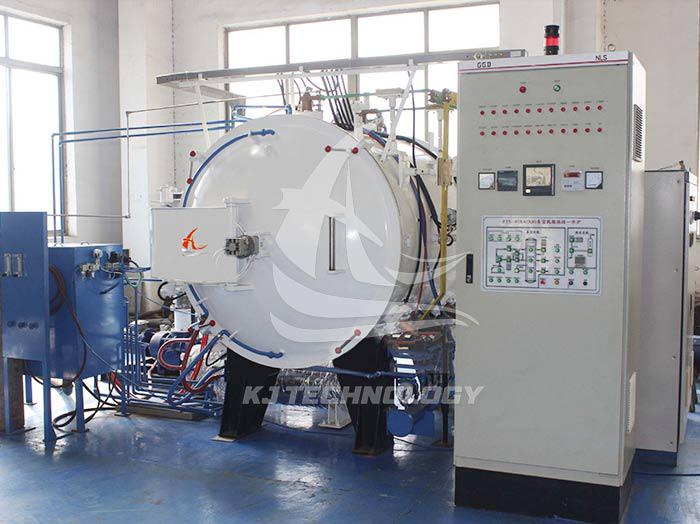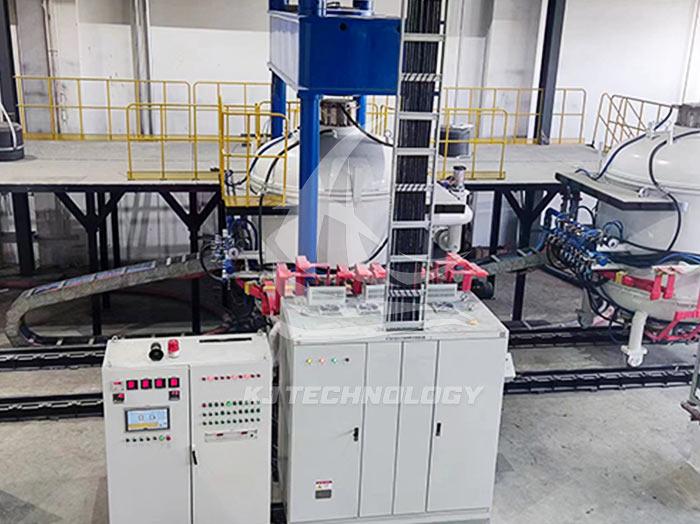What are the application ranges of vacuum atmosphere heat treatment furnaces?
 07-14-2025 Author: KJ technology
07-14-2025 Author: KJ technology
The vacuum atmosphere heat treatment furnace combines vacuum technology with controllable atmosphere environment to achieve performance optimization and process breakthroughs of key materials in multiple fields. Its application scope covers the following core areas:
1. Metal material processing: improving mechanical properties and surface quality
Conventional heat treatment
Annealing/tempering/solution treatment: Eliminating internal stresses in metals in vacuum or inert gases (such as argon) to improve cutting performance. For example, after vacuum annealing, the hardness uniformity of aviation bearing steel is improved by 2 HRC units, and the fatigue life is extended by 30%.
Vacuum brazing: By using a hydrogen reducing atmosphere to remove metal surface oxides, high-strength connections of dissimilar materials such as aluminum alloys and titanium alloys can be achieved, with joint strength reaching over 90% of the base material.
Special process support
Active metal treatment: Processing easily oxidizable metals such as titanium and zirconium in a vacuum environment to avoid the risk of combustion. For example, after vacuum solution treatment, the thickness of the surface oxide layer on titanium alloy blades decreased from the conventional treatment of 2 μ m to below 0.1 μ m.
Carburizing/nitriding: achieving surface hardening and improving wear resistance in a nitrogen or methane nitrogen mixed atmosphere. For example, after vacuum carburizing, the surface hardness of automotive gears reaches 60HRC, while the core toughness remains unchanged.
2. Powder metallurgy: preparation of high-performance composite materials
powder sintering
Hard alloy: Sintering tungsten carbide cobalt powder in vacuum or hydrogen atmosphere reduces porosity from 0.5% in conventional treatment to below 0.1%, and increases bending strength by 20%.
Metal based composite materials: By vacuum hot pressing sintering, ceramic particles (such as SiC, Al ₂ O3) are densely bonded with metal substrates (such as aluminum, magnesium), resulting in a 50% increase in thermal conductivity.
Fusion infiltration and alloying
Copper based contact material: Penetrating copper into a tungsten skeleton in a vacuum environment to form a highly conductive and arc resistant material, used for high-voltage switch contacts.
Nickel based high-temperature alloy: Through vacuum induction melting, the alloy composition (such as Cr, Co, Al content) is precisely controlled to meet the high temperature requirements of 1000 ℃ for aviation engine turbine discs.
3. Sintering of Ceramic Materials: Achieving High Density and Performance Optimization
Oxide ceramics
Transparent alumina ceramic: sintered in a hydrogen atmosphere to eliminate pores and reduce light scattering, with a transmittance increased from 85% to 92% in conventional processing, used for high-pressure sodium lamp tubes.
Zirconia ceramics: By vacuum sintering, abnormal grain growth is suppressed, and fracture toughness is increased from 6MPa · m ¹/² to 12MPa · m ¹/², used for dental implants.
Nitride ceramics
Aluminum nitride ceramics: sintered in a nitrogen atmosphere, with a thermal conductivity of 200W/(m · K), close to the theoretical value, used as heat dissipation substrates for high-power electronic devices.
Silicon nitride ceramics: After vacuum hot pressing sintering, the bending strength reaches 1000MPa and is used as a coating substrate for high-speed cutting tools.
4. Electronic Industry: Ensuring High Purity and Non Oxidation Treatment
Semiconductor device manufacturing
Transistor annealing: Annealing in a nitrogen or hydrogen atmosphere to reduce metal migration, reduce device leakage current from 10 ⁻⁶ A to 10 ⁻⁸ A, and improve reliability.
Integrated circuit packaging: Low stress connection between chips and substrates is achieved through vacuum soldering, reducing thermal resistance by 30% and extending device lifespan.
Electronic component processing
Magnetic material sintering: Sintering neodymium iron boron permanent magnets in vacuum or nitrogen atmosphere, increasing the coercivity from 12kOe to 15kOe, for use in new energy vehicle motors.
Polarization of piezoelectric ceramics: Polarization occurs in a silicone oil atmosphere, with the piezoelectric coefficient d ∝ increasing from 400pC/N to 600pC/N, used for ultrasonic transducers.
5. New material research and development: supports high-temperature synthesis and performance characterization
High temperature superconducting materials
YBCO superconductor: annealed in a vacuum oxygen composite atmosphere, the critical current density increased from 1MA/cm ² to 3MA/cm ², approaching the practical level.
Magnesium diboride superconductor: sintered by vacuum hot pressing, with a critical temperature of 39K, used in low-temperature magnetic resonance imaging (MRI) systems.
Nanomaterial synthesis
Carbon nanotubes: grown by chemical vapor deposition (CVD) in a vacuum furnace with a diameter uniformity of ± 0.5nm, used as reinforcing phases for high-strength composite materials.
Graphene: annealed in an argon atmosphere, with a layer control accuracy of ± 1 layer and a conductivity of 10 ⁶ S/m, used as electrodes for flexible display screens.
6. Aerospace: Meeting the requirements for extreme environmental use
Heat treatment of superalloy
Single crystal turbine blades: directionally solidified in a vacuum furnace to eliminate transverse grain boundaries, with a 50% increase in high-temperature endurance strength, used for high-pressure turbines in aircraft engines.
Nickel based alloy coating: By vacuum plasma spraying, a dense alumina coating is formed, and the oxidation resistance temperature is increased from 900 ℃ to 1100 ℃.
Titanium alloy processing
Aviation structural components: After vacuum annealing, the fatigue life of titanium alloys (such as Ti-6Al-4V) is increased from 10 ⁷ cycles to 10 ⁸ cycles, meeting the requirements of aircraft landing gear.
Titanium aluminum intermetallic compound: By vacuum hot pressing sintering, the density is increased from 4.2g/cm ³ to 4.5g/cm ³, used for low-pressure turbine blades.
7. Other fields: Expanding application boundaries
Glass manufacturing
Optical glass melting: Melting in a vacuum environment to avoid bubbles and stripe defects, increasing transmittance from 90% to 95%, used for high-precision lenses.
Glass sealing: achieved stress free connection between metal and glass through vacuum brazing, with a gas tightness of 10 ⁻¹² Pa · m ³/s, used for vacuum electronic devices.
chemical industry
Sintering of catalyst support: Sintering of alumina support in vacuum or nitrogen atmosphere increases the specific surface area from 100m ²/g to 200m ²/g, enhancing catalytic efficiency.
Corrosive material treatment: Treat hydrofluoric acid corrosive materials in a vacuum environment to avoid equipment corrosion and extend service life.








